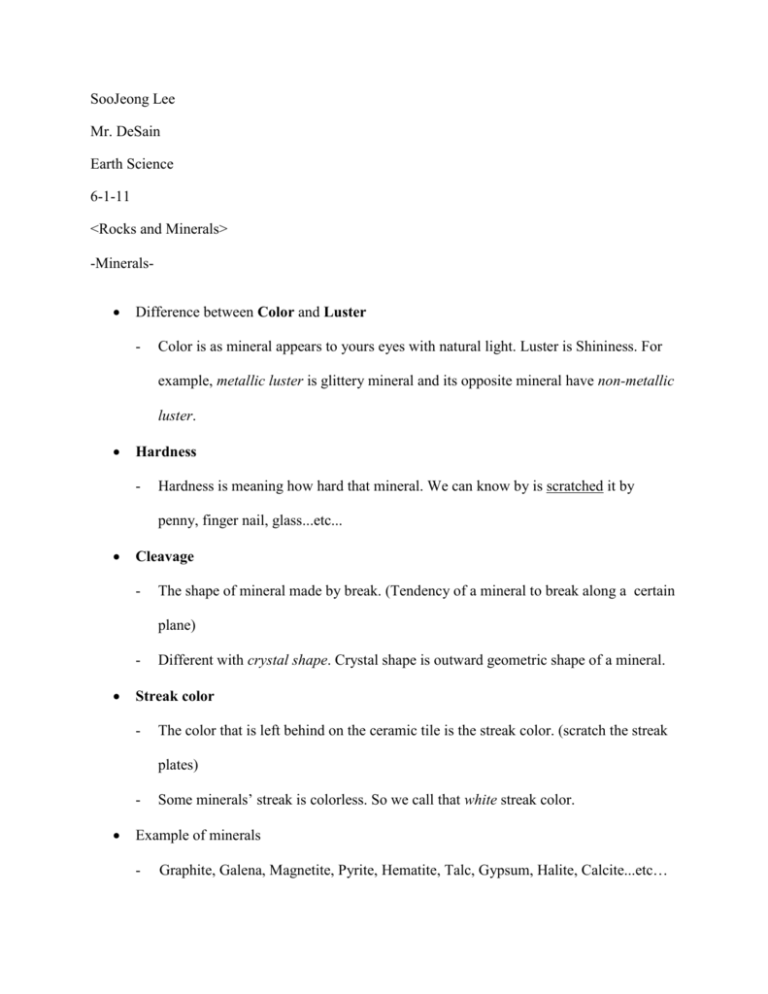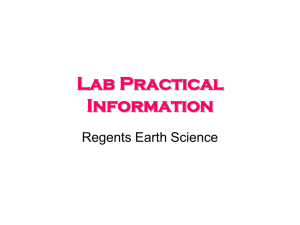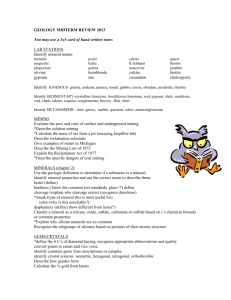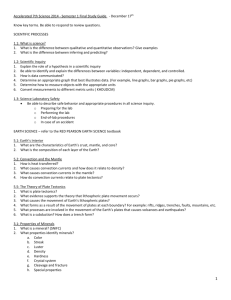ES review quiz (4th quarter project)
advertisement

SooJeong Lee Mr. DeSain Earth Science 6-1-11 <Rocks and Minerals> -Minerals Difference between Color and Luster - Color is as mineral appears to yours eyes with natural light. Luster is Shininess. For example, metallic luster is glittery mineral and its opposite mineral have non-metallic luster. Hardness - Hardness is meaning how hard that mineral. We can know by is scratched it by penny, finger nail, glass...etc... Cleavage - The shape of mineral made by break. (Tendency of a mineral to break along a certain plane) Different with crystal shape. Crystal shape is outward geometric shape of a mineral. Streak color - The color that is left behind on the ceramic tile is the streak color. (scratch the streak plates) Some minerals’ streak is colorless. So we call that white streak color. Example of minerals - Graphite, Galena, Magnetite, Pyrite, Hematite, Talc, Gypsum, Halite, Calcite...etc… -Rocks Igneous Rocks - Rocks that made by cooling and forming of magma (lava). If it’s made in the ground it calls intrusive igneous rock, if not, we call it extrusive igneous rock. - Intrusive igneous rocks are harder than extrusive igneous rocks. Because when the igneous rock cools in the air, it cools more quickly ; long cooling time = Big crystal size. - If it cools in water, it might be quenches (look like glass) - Obsidian, Pumice, Basaltic glass, Scoria, Vesicular andesite, Vesicular basalt, Rhyolite, Andesite, Basalt, Diabase, Granite, Diorite, Gabbro, Peridotite, Dunite, Pegmatite are Igneous rocks. They are made by Potassium, Quartz, Plagioclase, Biotite, Amphibole, Pyroxene, Olivine kind of minerals. (ESRT pg.6) Sedimentary Rocks - Clastic sedimentary rocks are containing sand, silt, or clay. They cemented together.(weathering) - Chemical sedimentary rocks (=evaporites) are formed from the precipitation and evaporation. Rock salt, rock gypsum, dolomite, limestone are chemical sedimentary rocks. - Bioclastic sedimentary rocks are made by shells, animals, and plants. (= Fossil) It made by organic materials. - Sedimentary rocks are form by deposition, which is deposited somewhere by water velocity. It also forms by compaction or Burial, which is made by the clasts pushing out together. Lastly they made by cementation, which is the hard cement that glues the clasts together. Metamorphic Rocks - It formed from a pre-existing rock that changed by heat, pressure and mineral fluids without weather or melting. - Contact metamorphism rocks are backed by magma (heat). Regional metamorphism rocks are made by high temperature and pressure and it they extremely folded. - Foliated rocks have layers of mineral crystals and Non-Foliated rocks form by added heat or pressure so it doesn’t have layer. Rock cycle - Igneous rocks can be metamorphic rock, Sedimentary can be metamorphic rock, and metamorphic rock can be metamorphic rock…etc… ------------Questions-----------1. Which extrusive igneous rock could be composed (4) Basalt of approximately 59% potassium feldspar, 28% 2. Which three minerals are most commonly found Quartz, 9% plagioclase feldspar, 2% biotite, in the igneous rock gabbro? 2%amphibole? (1) plagioclase feldspar, pyroxene, amphibole (1) Granite (2) quartz, plagioclase feldspar, biotite (2) Diorite (3) olivine, potassium feldspar, pyroxene (3) Rhyolite (4) potassium feldspar, quartz, biotite 3. The end product of the weathering of granite or 7. which sedimentary rocks are clastic and consist rhyolite is a solution of dissolved material that most of particles that have diameter smaller than 0.2cm likely would contain high amounts of and bigger than 0.0004cm? (1) aluminum, iron (1) shale, breccias (2) iron and magnesium (2) sandstone, shale (3) silicon, aluminum (3) sandstone, siltstone (4) fluorine, silicon (4) siltstone, conglomerate 4. which type of rock most likely contains fossils? 8. which rock is foliated, shows mineral alignment (1) basalt but not banding, and contains platy mica crystals (2) limestone visible from metamorphism of clay or feldspars? (3) gabbro (1) metaconglomerate (4) quartzite (2) phyllite 5. which rock is foliated, shows mineral alignment (3) slate but not banding, and contains coarse size of mica (4) schist and quartz? (1) marble (2) slate (3) dolostone (4) gneiss 6. Which rock is metamorphic rock? (1) hornfels (2) breccias (3) diabase (4) rock gypsum 9. which relative concentrations of elements are found in a mafic rock? (1) a high concentration of aluminum and a low concentration of magnesium (2) a high concentration of iron and a low concentration of silicon (3) a high concentration of magnesium and a low concentration of aluminum (4) a high concentration of silicon and a low concentration of iron 10. According to the Earth Science Reference 14. which mineral has cleaves in 2 directions at 90◦ Tables, pumice and scoria are alike in that they both and used as ceramics, glass? are (1) pyroxene (1) mafic (2) potassium feldspar (2) very coarse (3) amphibole (3) intrusive (4) fluorite (4) non-crystalline 11. The mineral talc is often used as 15. Most metamorphic rocks form by which processes? (1) ore of sulfur (1) compaction and cementation (2) glass, ceramics (2) melting and solidification (3) ceramics, paper (3) erosion and deposition (4) cement, lime (4) heat and pressure 12. which mineral will scratch human fingernail 16. Which mineral scratches calcite and is scratched (hardness = 2.5), and it has metallic luster, but not by fluorite? galena? (1) quartz (1) graphite (2) pyroxene (2) olivine (3) halite (3) calcite (4) dolomite (4) sulfur 13. which mineral leaves a white- yellow powder when rubbed against an unglazed porcelain plate? (1) sulfur (2) magnetite (3) galena (4) hematite 17. Which statement about the rock cycle is not true? (1) a metamorphic rock in the future may change into another type of metamorphic rock (2) Deposition and burial are processes that lead to sedimentary rocks (3) Igneous rock can be another type of igneous rock without melting (4) if sedimentary rock get heat and/or pressure, it can be a metamorphic rock 18. Which sedimentary rock contains organic or cemented shell fragments material? (1) limestone (2) pegmatite (3) rock salt (4) quartzite 19. What kind of igneous rock has a coarse nonvesicular texture and it composed mainly of pyroxene and olivine? 20. Which sedimentary rock is made up of the smallest particles? (1) conglomerate (2) shale (3) sandstone (4) gneiss









